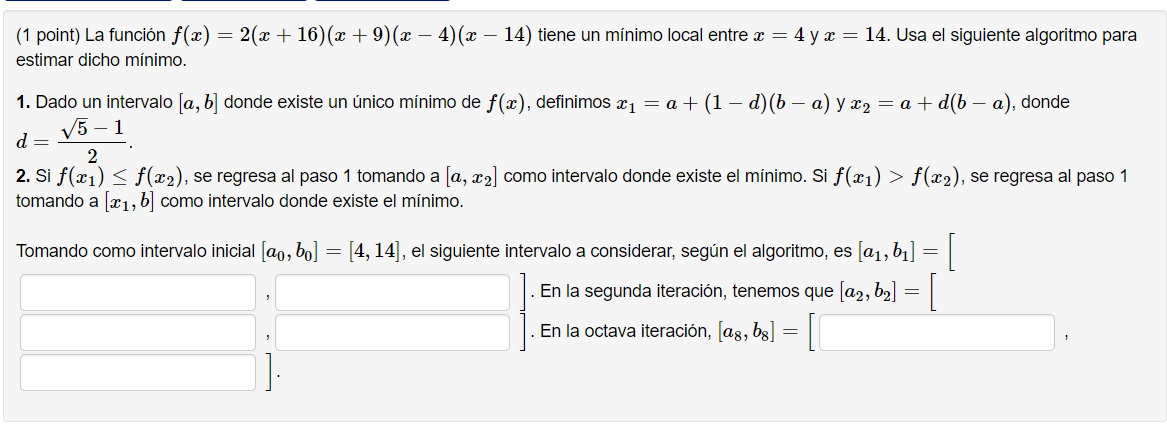Home /
Expert Answers /
Advanced Math /
1-point-the-function-f-x-2-x-16-x-9-x4-x14-has-a-local-minimum-between-x-4-and-x-14-u-pa774
(Solved): (1 point) The function f(x)=2(x+16)(x+9)(x4)(x14) has a local minimum between x=4 and x=14. U ...
(1 point) The function f(x)=2(x+16)(x+9)(x?4)(x?14) has a local minimum between x=4 and x=14. Use the following algorithm to estimate that minimum. 1. Given an interval [a,b] where there is a unique minimum of f(x), we define x1=a+(1?d)(b?a) and x2=a+d(b?a), where d= (?5?1)/2. 2. If f(x1)?f(x2), go back to step 1 taking [a,x2] as the interval where the minimum exists. If f(x1)>f(x2), we return to step 1 taking [x1,b] as the interval where the minimum exists. Taking as initial interval [a0,b0]=[4,14], the next interval to consider, according to the algorithm, is [a1,b1]=[ , ]. In the second iteration, we have that [a2,b2]=[ , ]. On the eighth iteration, [a8,b8]=[ , ].
(1 point) La función ƒ(x) = 2(x + 16)(x + 9) (x ? 4)(x ? 14) tiene un mínimo local entre x = 4 yx = 14. Usa el siguiente algoritmo para estimar dicho mínimo. 1. Dado un intervalo [a, b] donde existe un único mínimo de f(x), definimos x? = a + (1 ? d)(b ? a) y x? = a + d(b ? a), donde - ?5-1 d= 2 2. Si f(x1) ? f(x2), se regresa al paso 1 tomando a [a, x?] como intervalo donde existe el mínimo. Si f(x?) > ƒ(x2), se regresa al paso 1 tomando a [x?, b] como intervalo donde existe el mínimo. Tomando como intervalo inicial [ao, bo] = [4, 14], el siguiente intervalo a considerar, según el algoritmo, es [a?, b?] = [ En la segunda iteración, tenemos que [a2, b2] = [ . En la octava iteración, [ag, bg] = [[
